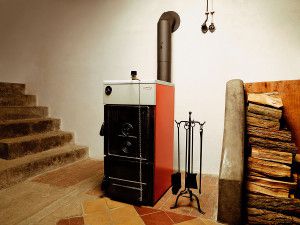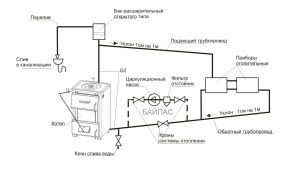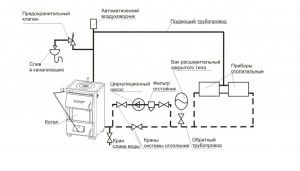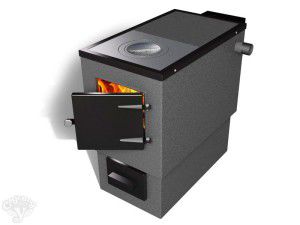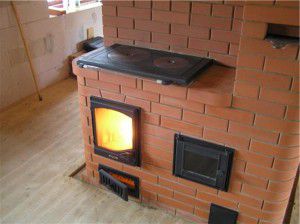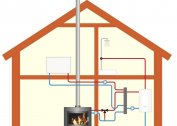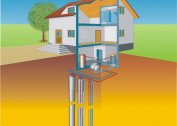Organization of heating with the help of a solid fuel boiler requires attention maximization and knowledge of the nuances of drawing up a diagram and installing equipment. Such a system is relevant to use in the absence of the ability to connect the gas main or in the presence of relatively cheap solid fuel. We will consider options for how to make solid fuel heating of a private house with a boiler and stove, schemes and selection parameters.
Rules for the organization of solid fuel heating
The main difference that a heating system with a solid fuel boiler has a closed type is the type of fuel used. Coal, firewood, peat or fuel briquettes are used as an energy carrier. All of them are characterized by high energy intensity and, as a result, intense heat generation.
In order to make heating a solid fuel boiler with your own hands, you will need to familiarize yourself with the rules of its organization. They directly depend on the selected scheme, pipe routing system and the coolant used.
A characteristic feature is the correct installation of heating with a solid fuel boiler. The heat source and fuel must be in different rooms, and in addition to the installation rules, safety measures for the operation of heating are observed.
The basic rules for the design and practical implementation of the scheme of heating systems for solid fuel boilers and furnaces are as follows:
- Use of non-combustible materials. When installing a stove or boiler, the floor, walls and ceiling in the chimney area must be fireproof. Those. when exposed to high temperatures, these materials should not spontaneously ignite or smolder;
- Work stabilization. The main danger in the operation of a solid fuel boiler for water heating is overheating of water in the heat exchanger. To prevent this, it is possible in a boiler or furnace to regulate the air supply necessary to maintain the combustion process of firewood. It can be a system of valves connected to a mechanical temperature controller;
- Supply and exhaust ventilation. The classic heating installation scheme from a solid fuel boiler provides for air exchange in the room where the equipment is installed. During its operation, combustion products will inevitably fall into the room. Supply and exhaust ventilation will remove them, thereby preventing a concentration of CO2 hazardous to humans.
Install factory or home-made solid fuel heating boilers should be in separate boiler rooms. Exceptions are low power models that are equipped with a hob. But in this case, the kitchen must provide all security measures.
The basic rules for the arrangement of boiler houses in which double-circuit solid fuel heating boilers will be installed are described in SNiP II-35-76. Before installing the equipment you need to familiarize yourself with this document.
Solid-fuel water heating schemes with a boiler
The choice of a heating scheme is the first stage in the design of a house’s heat supply. When using solid fuel equipment, special attention is paid to the installation and connection diagram of the solid fuel boiler to the heating system. Installation instructions are directly dependent on the type of heat supply and pipe layout.
The most common heating scheme is an open system. This is due to the fact that a solid fuel boiler for heating a private house can overheat. In a closed system pressure stabilization is provided by a membrane expansion tank and a safety group. But if temperature and thermal expansion reach a critical point, a rupture of pipes may occur.
For an open system, two-pipe wiring is recommended. In such a scheme for connecting a solid fuel boiler to the heating system, the following heat supply parameters will be provided:
- Uniform distribution of thermal energy. The coolant flow will be artificially divided for each radiator;
- Operational safety. This is important when installing a homemade solid fuel heating boiler;
- The possibility of expanding the heating area. It depends on the capacity of the equipment. In the heating installation scheme from a solid fuel boiler, a power reserve should be provided for connecting additional radiators and batteries;
The disadvantage of this scheme of heating systems for solid fuel boilers is the large diameter of the pipes - from 32 to 40 mm. This entails an increase in the volume of coolant and, as a result, a large fuel consumption to maintain the required temperature level. Therefore, when installing heating with a solid fuel boiler, preference is given to a closed circuit.
The difference lies in the creation of an increased pressure inside the system from 1.5 to 4 atm. Modern heating systems with a solid fuel boiler of a closed type more stable support the work of heat supply, require less fuel. Pipes with a diameter of 16 to 24 mm are used to install the supply lines. This entails a decrease in the volume of coolant compared to an open system.
Professional installation of a dual-circuit solid fuel heating boiler in a closed system is possible only with the following components:
- Diaphragm expansion tank. It is necessary to compensate for small pressure surges in the system. Mounted on the return pipe;
- Security group - air vent, drain valve. The primary unit in heating with a solid fuel boiler is mounted on a supply pipe immediately after the boiler. It is also mandatory to install an air vent at the highest point in the system;
- Circulation pump. With its help, the velocity of the coolant increases, the thermal distribution stabilizes.
In a heating system with a solid fuel boiler of a closed type, pressure and temperature sensors are mounted to control the operation. The same set of devices should be in the boiler. If they are not available in the configuration - you should purchase and install them.
The least common is the collector heat supply with a solid fuel boiler with your own hands. This is due to the high consumption of materials. Similar schemes for installing heating from a solid fuel boiler are relevant for homes with an area of 200 m² or more.
Air heating with solid fuel boiler
Solid fuel boilers for air heating are an alternative to water heating. They differ not only in the type of coolant, but also in design. To form a circulation of warm air flows in solid fuel boilers of air heating, a pipe system is installed.
They are designed for heating small rooms. Since air heating occurs due to the system of channels in the boiler design - in this way it is impossible to maintain the temperature in other rooms of the house. The advantage of such a heat supply is the unnecessary drawing up of a scheme for a heating system with a solid fuel boiler. It is important to choose the location of the structure in the room so that uniform heating of the air occurs.
Features of operation and operation of solid fuel boilers for air heat supply are as follows:
- Minimum initial expenses for the organization of heating. In contrast to the configuration of solid fuel boilers for water heating with pipes and radiators, for the installation of air heat supply it is enough to purchase only a stove;
- Design mobility. Judging by the reviews, solid fuel heating boilers can be quickly installed in another room. It is important that there is a chimney to connect to the boiler;
- The possibility of self-manufacturing. It is only important to choose the design scheme and material. But many home-made solid fuel boilers for heating have worse characteristics than factory models.
Another drawback of this type of equipment is the absence in the model range of double-circuit solid fuel boilers for heat supply. There are options for installing an indirect heating tank on a chimney, similar to sauna stoves. But the capacity will not be large enough to provide hot water.
Despite the ease of installation of solid fuel heating with an air-type boiler, all the same, all safety measures for its operation should be ensured - air circulation in the room, fire safety.
Solid fuel water heating schemes
The stove is a traditional source of heat in a private house. However, for buildings with a large area, the installation of classic models will be inappropriate. This is due to the relatively low efficiency and limitation of heat distribution. Therefore, a solid fuel furnace with a water heating boiler is increasingly being installed.
Structurally, factory models are similar to boilers, but have a number of features. First of all - small size. Since the main task of a solid fuel furnace with a water heating boiler is to provide heat supply over a relatively small area - the maximum power of such structures is usually 9-10 kW. This disadvantage is offset by the affordable cost and ease of installation. Unlike solid fuel boilers for water heating, the stove can have an additional function - the hob. Because they are installed in the kitchen.
Most often, steel furnaces with a water heating circuit are purchased to heat a summer house or a small country house. Due to their unique properties, these radiators have a number of advantages:
- Small size. It allows you to place the design on a limited area of the kitchen in the house;
- Solid fuel type selection. For the operation of a solid fuel furnace with a water heating boiler, coal, firewood, peat or fuel briquettes can be used;
- Simple installation. To install the furnace, just connect it to the pipes of the heating system.
When choosing a furnace with a water circuit, you should pay attention to the characteristics of the material of manufacture. The case must be made of steel with a thickness of 2 mm or more. In a heat exchanger, for long-term operation, the manufacturer must use heat-resistant sheet steel with a thickness of 3 mm or more.
Many summer residents use ash (a product of fuel combustion) to fertilize household plots. Therefore, fuel briquettes are especially popular. They are not only economical, but also in their ash contains a large number of mineral components.
Solid-fired brick air heating
With the correct organization of air heating using a solid fuel furnace, it is possible to ensure stable thermal conditions in a house with a small and medium area. One of the best options in this case may be brick solid fuel stoves for air heating.
In this case, air heating occurs through the walls of the structure and through the complex system of chimneys - coarse. Therefore, all brick solid-fuel furnaces for air heating have impressive dimensions. It is important to choose the right masonry scheme, since it is necessary to observe the proportions of honey with the combustion chamber and other structural elements. In the event of an error, the efficiency of the furnace will be low, which will not provide the proper level of heating of the air in the house.
Important steps in arranging air heating with a brick oven are:
- Installation of a separate foundation. The total mass of the structure is high - an ordinary brick screed will not withstand it. Therefore, before laying the furnaces, a separate foundation is arranged, which should not be connected with the brownies;
- Chimney. Traditionally, for a brick oven, a chimney is made of the same material. However, due to its square section, it does not have high traction. Therefore, it is recommended to install modern sandwich chimneys made of heat-resistant galvanized steel and a layer of insulation from basalt wool;
- Device rude. This is a system of smoke channels located in the inner wall of the house. Passing through them, the heated air additionally heats up not only the room where the stove is installed, but also the rooms adjacent to it.
It is important to choose the right lining material for a solid propellant air heating furnace. Along with the traditional silicate brick, you can use artificial stone or ceramic tiles. They must have a sufficiently large heat capacity so that after the final burning of the fuel, the air in the room can still be heated for some time from the walls of the furnace.
In addition, a water heat exchanger can be installed in the combustion chamber of the brick furnace to connect it to the heating system. This is done even at the construction stage, since the modernization of an already folded furnace is laborious.
Solid fuel heating reviews
One way to create an objective opinion about this type of heat supply is to familiarize yourself with the reviews. They can be both positive and negative. It all depends on the correct choice of type of heating, its installation and further operation. Consider the most common reviews of solid fuel heating boilers:
- We decided to replace the old small brick stove with a new steel stove in the country. After a long period of choice, we settled on a model with a heat exchanger. We hope to make water heating in the future, since the air from the old stove did not warm evenly, dampness appeared throughout the house;
- Our neighbors made a brick oven for themselves. First impressions are large and consume a lot of firewood. However, having got a closer look, we realized that this is exactly what we need. We have a small house (60 m²) with two rooms and a kitchen. We don’t want to put the boiler, so we decided to order the services of a stove-maker. We hope that the oven will last a long time.
The advantage of solid fuel heating is a relatively quick upgrade to a different type of fuel. Almost all boiler models are designed for the installation of a gas or diesel burner. Therefore, if it is planned to supply a gas main to the house, you can safely purchase a solid fuel boiler, in which you can install a burner.
In the video material you can see an example of self-production of a solid fuel boiler:
